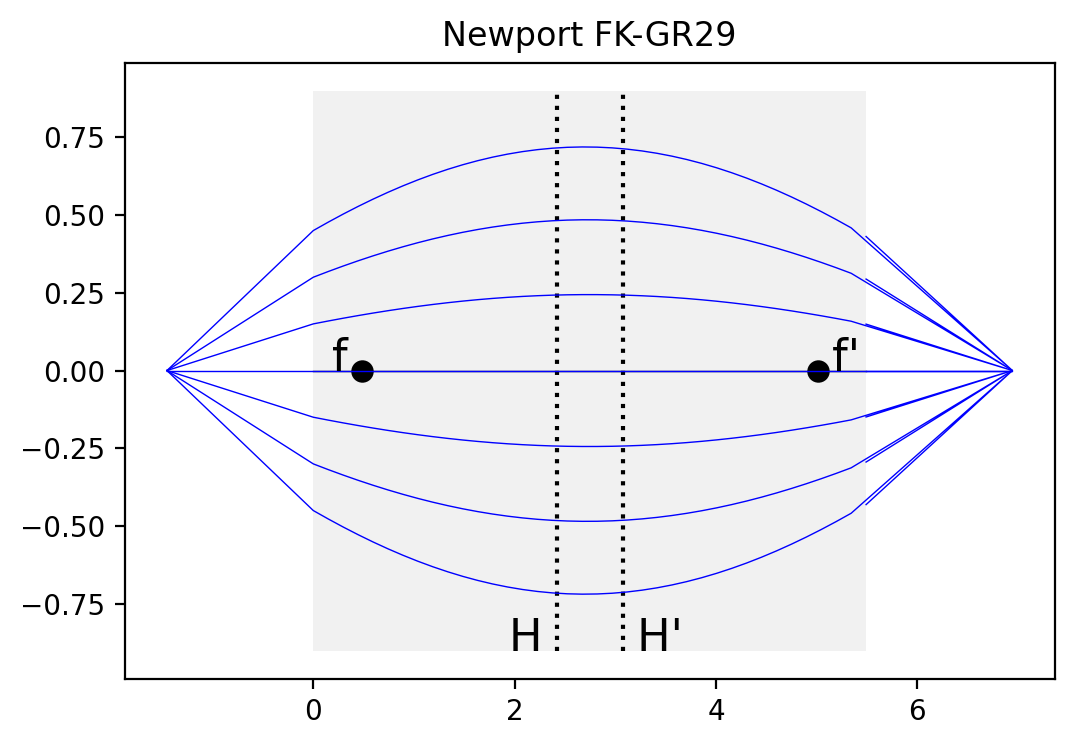Gradient Index Lenses
Scott Prahl
Sept 2023
[2]:
import numpy as np
import matplotlib.pyplot as plt
import matplotlib.patches as patches
import pygrin
%config InlineBackend.figure_format='retina'
Pitch of a GRIN lens
A gradient index (GRIN) lens is characterized by a sinusoidal ray path along the lens. A lens is typically characterized by its pitch or the number of sinusoidal periods within the lens.
If the pitch is one (or an integer) then the grin lens acts as a relay and reproduces the light incident on the entrance surface at the exit surface. A half-pitch inverts the pattern. A quarter-pitch lens will collimate a point source or focus a collimated incident beam.
[7]:
n0 = 1.608 # centerline index of refraction
length = 1 # mm
diameter = 0.25 # mm
angle = 40*np.pi/180 # radians
xpos = 0
pitch = 1
radius = diameter/2
# max angle in air
max_angle = pygrin.max_angle(n0,pitch,length,diameter)
# range of launch angles
angles = np.linspace(-max_angle,max_angle,6)
# range of launch angles in grin lens
angles = np.arcsin(np.sin(angles/n0))
plt.subplots(2,1,figsize=(10,10))
plt.subplot(2,1,1)
for angle in angles:
z,r = pygrin.meridional_curve(n0, pitch, length, xpos, angle)
plt.plot(z,r, lw=0.5)
plt.plot([0.25*length,0.25*length],[-radius,radius],':k')
plt.plot([0.5*length,0.5*length],[-radius,radius],':k')
plt.xticks([0,0.25,0.5,1.0])
plt.yticks([])
plt.xlabel('Pitch')
plt.title('Full Pitch GRIN Lens, Focus-to-Focus')
plt.subplot(2,1,2)
for xpos in np.linspace(-radius,radius,6):
z,r = pygrin.meridional_curve(n0, pitch, length, xpos, 0)
plt.plot(z,r, lw=0.5)
plt.plot([0.25*length,0.25*length],[-radius,radius],':k')
plt.plot([0.5*length,0.5*length],[-radius,radius],':k')
plt.xticks([0,0.25,0.5,1.0])
plt.yticks([])
plt.xlabel('Pitch')
plt.title('Full Pitch GRIN Lens, Parallel-to-Parallel')
plt.tight_layout() # Ensures proper spacing
#plt.savefig('pitch.png', dpi=300)
plt.show()
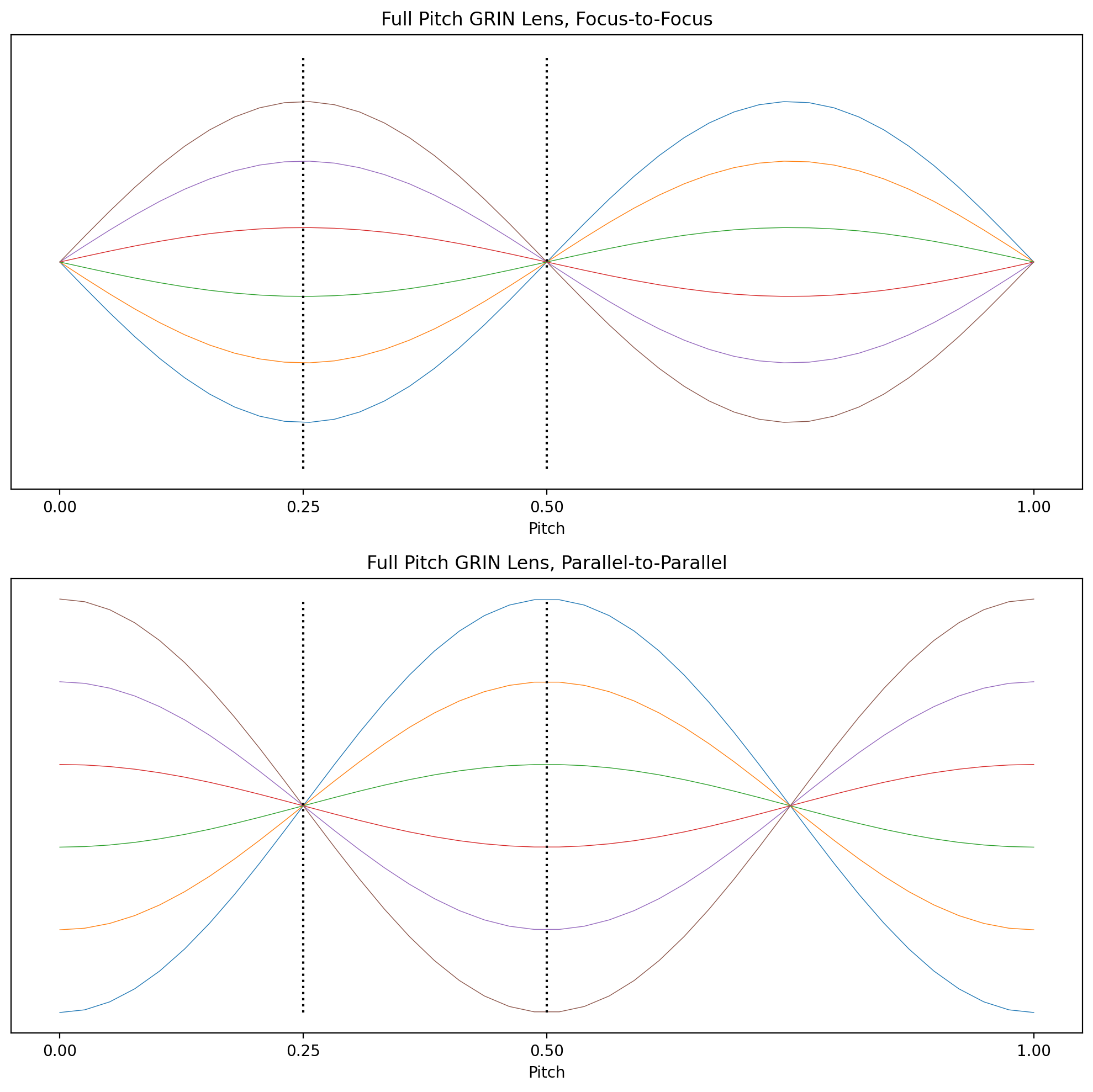
Quarter Pitch
This is the typical example because collimated light is focused to a point, or conversely, a point source is collimated. Here we see an example the former.
[3]:
pitch = 0.25
n0 = 1.608 # centerline index of refraction
length = 5 # mm
diameter = 2 # mm
angle = 0*np.pi/180 # radians
pygrin.plot_principal_planes(n0, pitch, length, diameter)
xpos = np.linspace(-diameter/2,diameter/2,9)
for pos in xpos:
z,r = pygrin.meridional_curve(n0, pitch, length, pos, angle)
plt.plot(z,r, color='blue',lw=0.5)
plt.rcParams["figure.figsize"] = [10,3]
plt.axis('off')
plt.show()
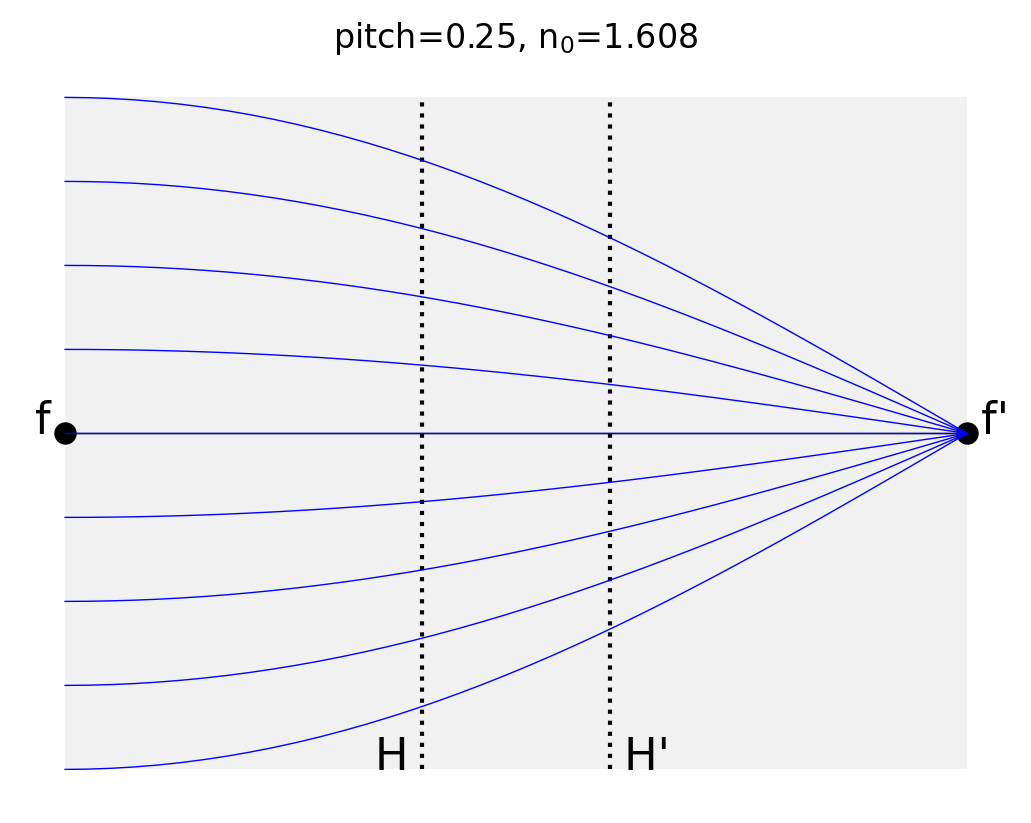
This shows light being collimated from a point source
[4]:
pitch = 0.25
n0 = 1.608 # centerline index of refraction
length = 5 # mm
diameter = 2 # mm
xpos = 0 # mm
pygrin.plot_principal_planes(n0, pitch, length, diameter)
# max angle in air
max_angle = pygrin.max_angle(n0,pitch,length,diameter)
# range of launch angles
angles = np.linspace(-max_angle,max_angle,9)
# range of launch angles in grin lens
angles = np.arcsin(np.sin(angles/n0))
for angle in angles:
z,r = pygrin.meridional_curve(n0, pitch, length, xpos, angle)
plt.plot(z,r, color='blue',lw=0.5)
plt.rcParams["figure.figsize"] = [10,3]
plt.axis('off')
plt.show()
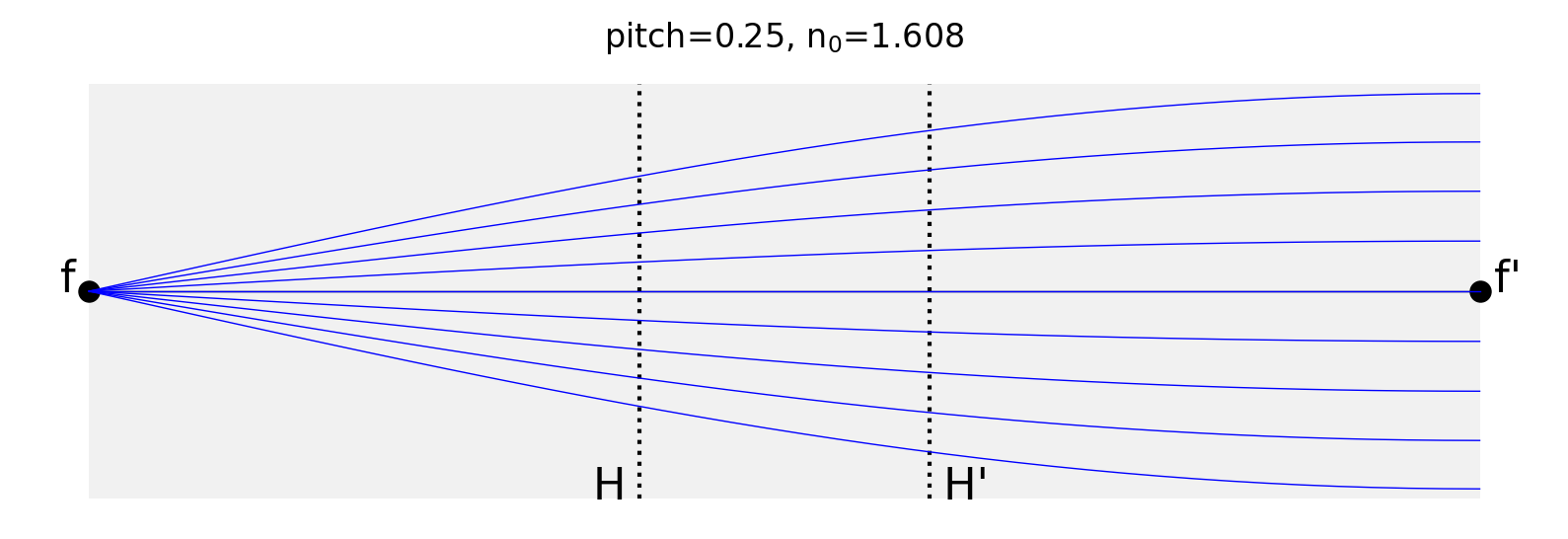
Here is a 4f system. Here the source on the left is on focal distance from the front face and the
[5]:
# 4f system
pitch = 0.25
n0 = 1.608 # centerline index of refraction
length = 5 # mm
diameter = 2 # mm
zobj = pygrin.EFL(n0,pitch,length)
xpos = np.linspace(-diameter/4,diameter/4,9)
pygrin.plot_principal_planes(n0, pitch, length, diameter)
for pos in xpos:
z,r = pygrin.full_meridional_curve(n0, pitch, length, -zobj, 0.0, pos)
plt.plot(z,r, color='blue',lw=0.5)
plt.rcParams["figure.figsize"] = [10,3]
plt.axis('off')
plt.show()
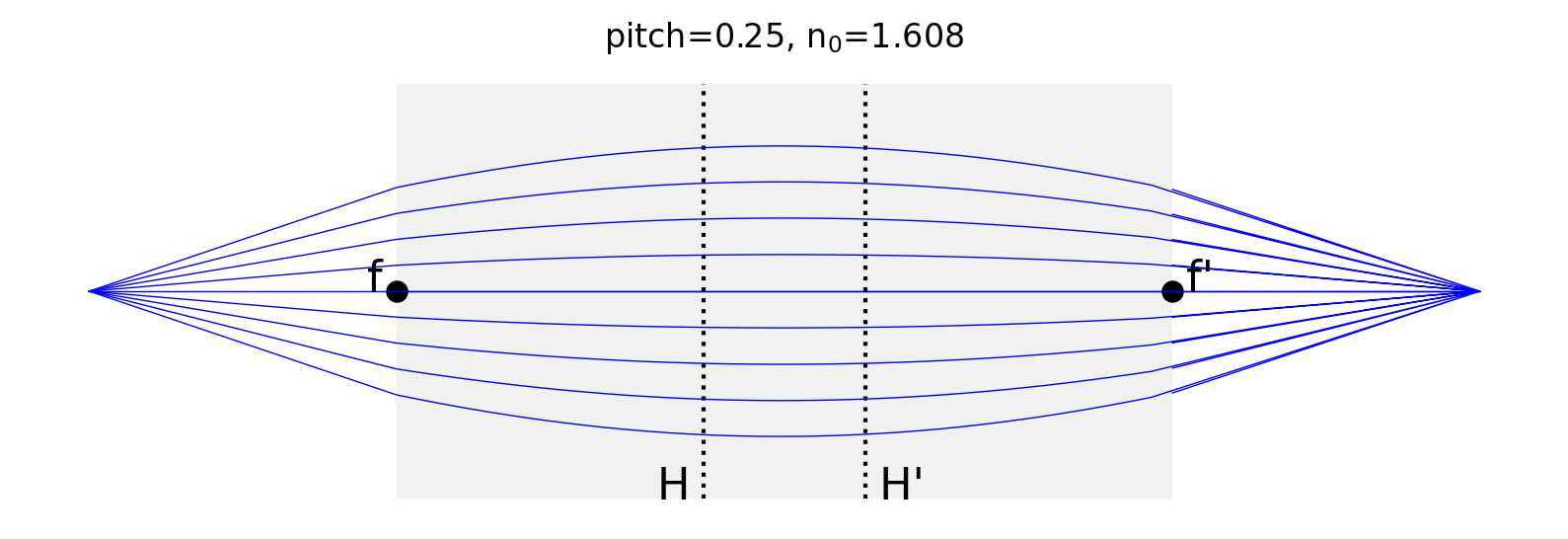
Finally, this shows that collimated light incident at an angle on the lens will be imaged to a point off-axis.
[6]:
# off axis launch
pitch = 0.25
n0 = 1.608 # centerline index of refraction
length = 5 # mm
diameter = 2 # mm
zobj = pygrin.EFL(n0,pitch,length)
xpos = np.linspace(-diameter/4,diameter/4,9)
pygrin.plot_principal_planes(n0, pitch, length, diameter)
for pos in xpos:
z,r = pygrin.full_meridional_curve(n0, pitch, length, -zobj, pos-0.1, pos)
plt.plot(z,r, color='blue',lw=0.5)
plt.rcParams["figure.figsize"] = [10,3]
plt.axis('off')
plt.show()
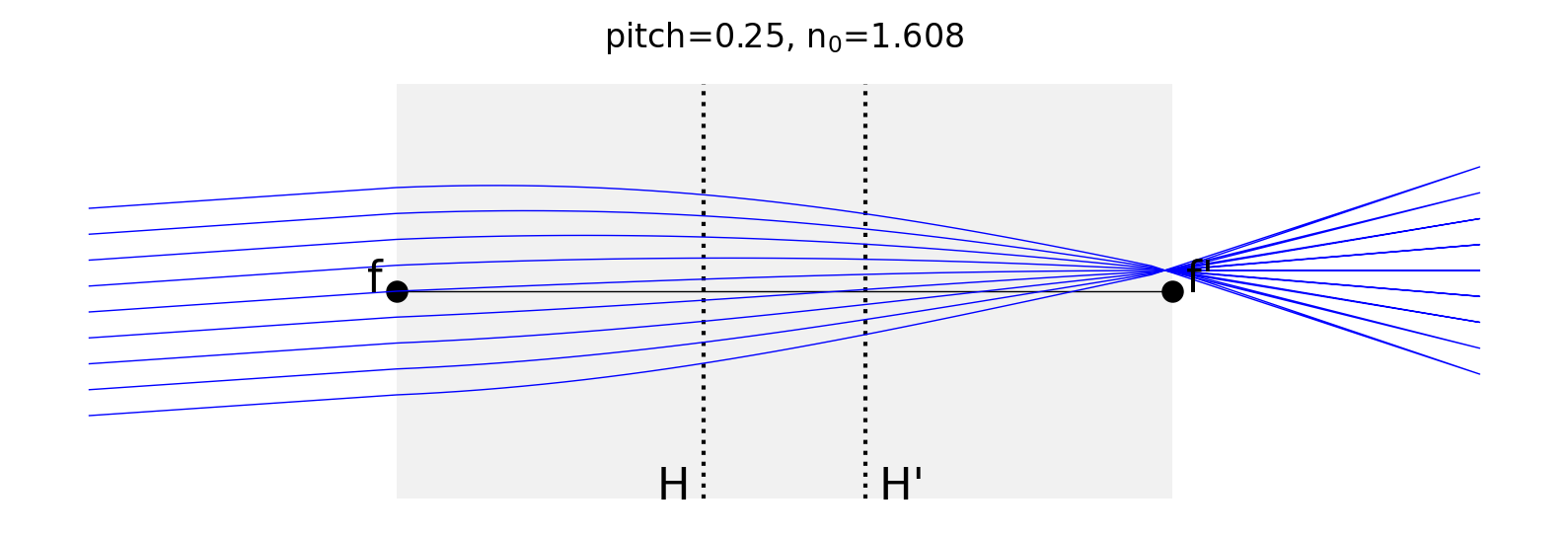
Half Pitch
Here we show that all the rays hitting the front surface at a point are imaged to the same point on the exit surface — but inverted.
The prinicipal planes are not drawn because the effective focal length is infinite.
[7]:
pitch = 0.5
n0 = 1.608 # centerline index of refraction
length = 5 # mm
diameter = 2 # mm
xpos = 0.5 # mm
pygrin.plot_principal_planes(n0, pitch, length, diameter)
# max angle in air
max_angle = pygrin.max_angle(n0,pitch,length,diameter)
# range of launch angles
angles = np.linspace(-max_angle,max_angle,9)
# range of launch angles in grin lens
angles = np.arcsin(np.sin(angles/n0))
for angle in angles:
z,r = pygrin.meridional_curve(n0, pitch, length, xpos, angle)
plt.plot(z,r, color='blue',lw=0.5)
plt.rcParams["figure.figsize"] = [10,3]
plt.axis('off')
plt.show()
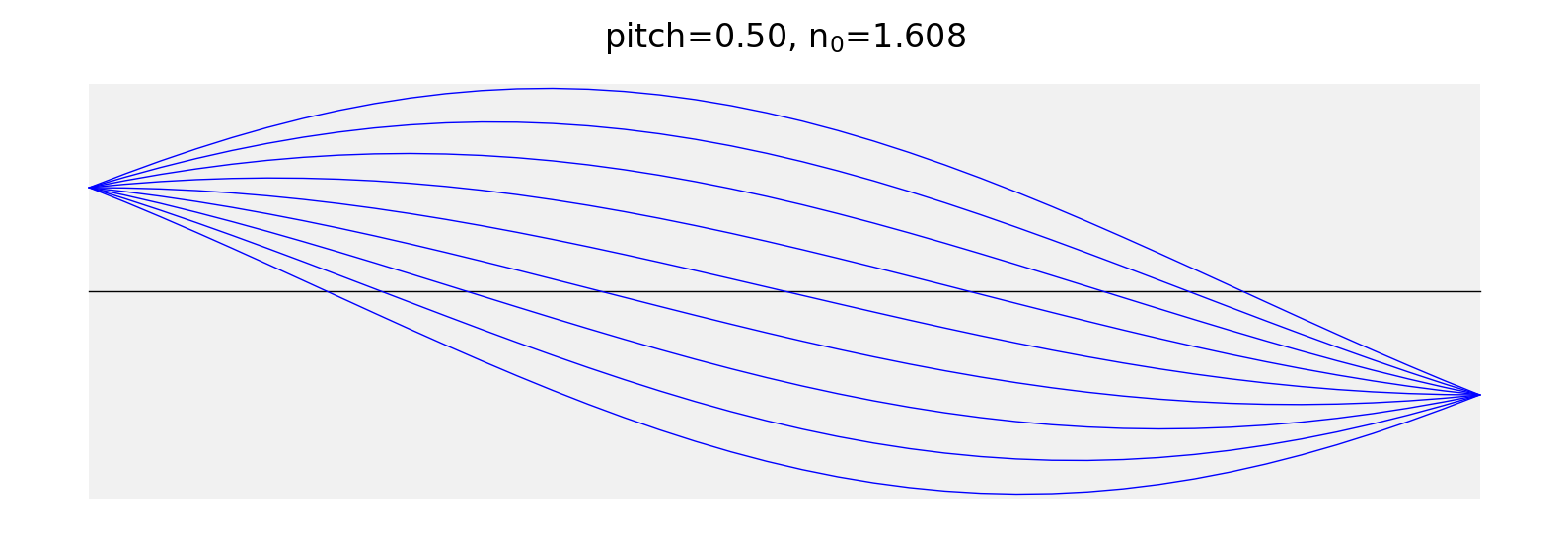
Index of Refraction Across Lens
Parabolic Profile
[8]:
n0 = 1.608
pitch = 0.25
length = 5 # mm
diameter = 2
r = np.linspace(-diameter/2,diameter/2,50)
plt.plot(r,pygrin.parabolic_profile_index(n0,pitch,length,r))
plt.plot([0,0],[1.53,n0],':k')
plt.xlabel('Radius (mm)')
plt.ylabel('Index of Refraction')
plt.title(r'pitch=%.2f, n$_0$=%.3f, length=%.2fmm'%(pitch,n0,length))
plt.rcParams["figure.figsize"] = [6,4]
plt.show()
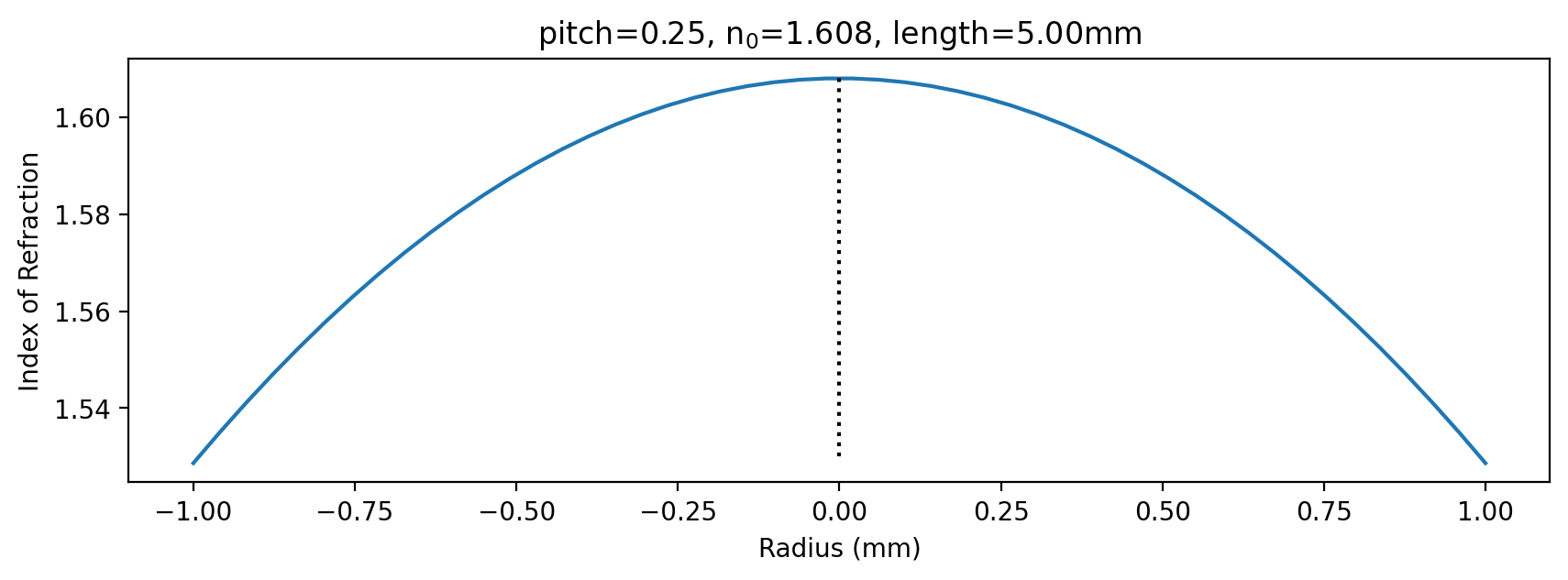
Hyperbolic Secant Profile
This has a few advantages over the parabolic profile: the propagation for a HS grin lens can be solved exactly and there aren’t any aberrations for meridional rays.
As you can see below, the HS profile can be quite close to the parabolic profile.
[9]:
n0 = 1.608
pitch = 0.19
length = 5 # mm
diameter = 2
gradient = pygrin.gradient(pitch,length)
alpha = 1.303*gradient
r = np.linspace(-diameter/2,diameter/2,50)
plt.subplots(2,1, sharex=True,figsize=(6,6))
plt.subplot(2,1,1)
n_p = pygrin.parabolic_profile_index(n0,pitch,length,r)
n_s = pygrin.hyperbolic_secant_profile_index(n0,alpha,r)
plt.plot(r,n_p)
plt.plot(r,n_s)
plt.xticks([])
plt.ylabel('Index of Refraction')
plt.title(r'pitch=%.2f, n$_0$=%.3f, length=%.2fmm'%(pitch,n0,length))
plt.rcParams["figure.figsize"] = [6,4]
plt.subplot(2,1,2)
plt.plot(r,n_p-n_s)
plt.xlabel('Radius (mm)')
plt.ylabel('Difference')
plt.plot([-1,1],[0,0],':k')
plt.show()
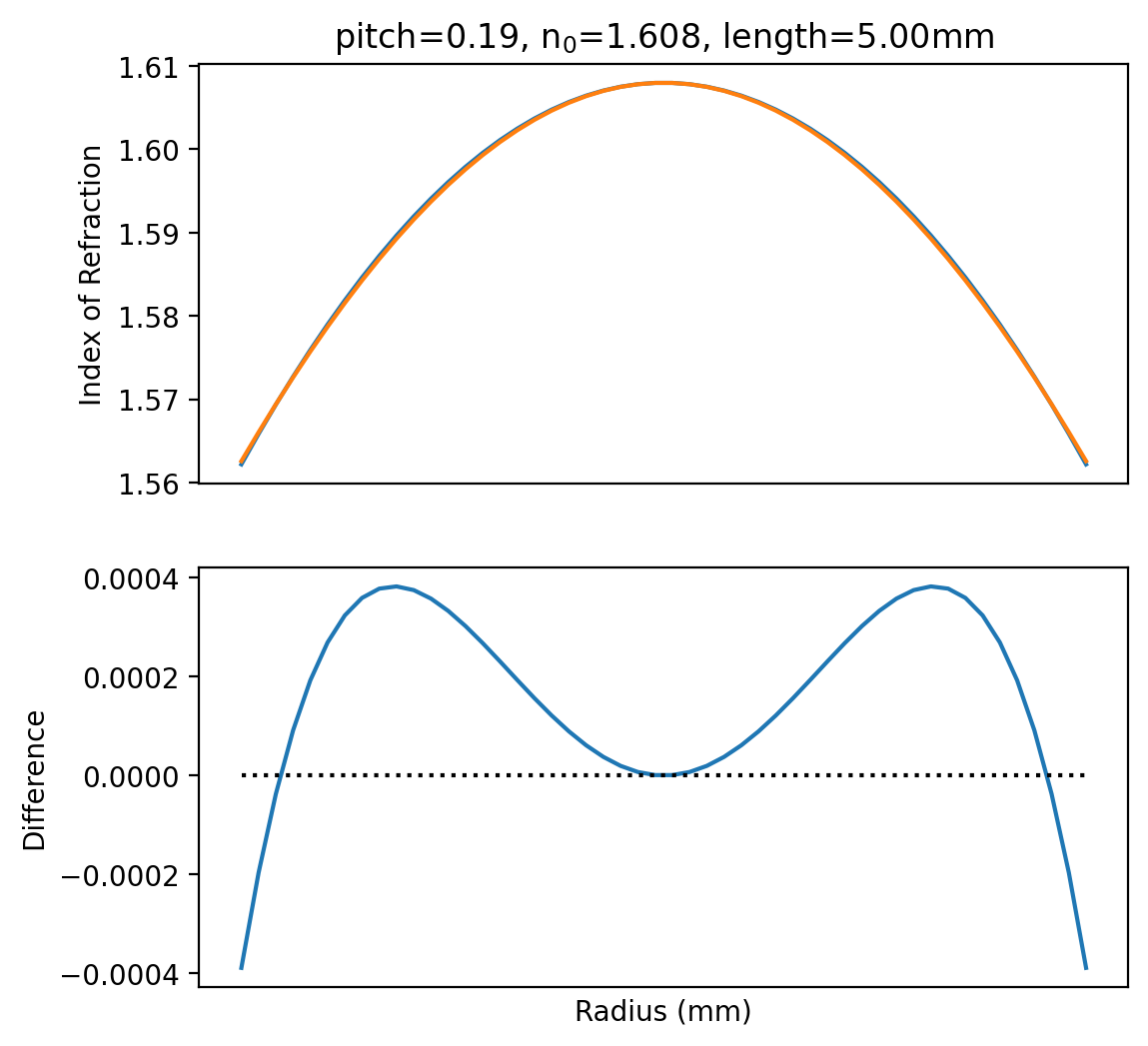
Catalog Examples
Grin Lens from ancient Melles Griot Catalog, 4.67 line 2
Part number LGS-0.25-1.0-2.58-633
[10]:
n = 1.608
gradient = 0.608
length = 2.58
diameter = 1
pitch = pygrin.period(gradient, length)
print('expected pitch = 0.25, calculated %.2f'%pitch)
efl = pygrin.EFL(n,pitch,length)
na = pygrin.NA(n,pitch,length,diameter)
print('expected NA = 0.46, calculated %.2f'%na)
angle = pygrin.max_angle(n,pitch,length,diameter)
print('expected full accept angle = 55°, calculated %.0f°'%(2*angle*180/np.pi))
expected pitch = 0.25, calculated 0.25
expected NA = 0.46, calculated 0.46
expected full accept angle = 55°, calculated 54°
[11]:
r = np.linspace(-0.5,0.5,50)
plt.plot(r,pygrin.parabolic_profile_index(n,pitch,length,r))
plt.xlabel('Radius (mm)')
plt.ylabel('Index of Refraction')
plt.title('pitch=%.3f, n0=%.3f, L=%.2fmm'%(pitch,n,length))
plt.show()
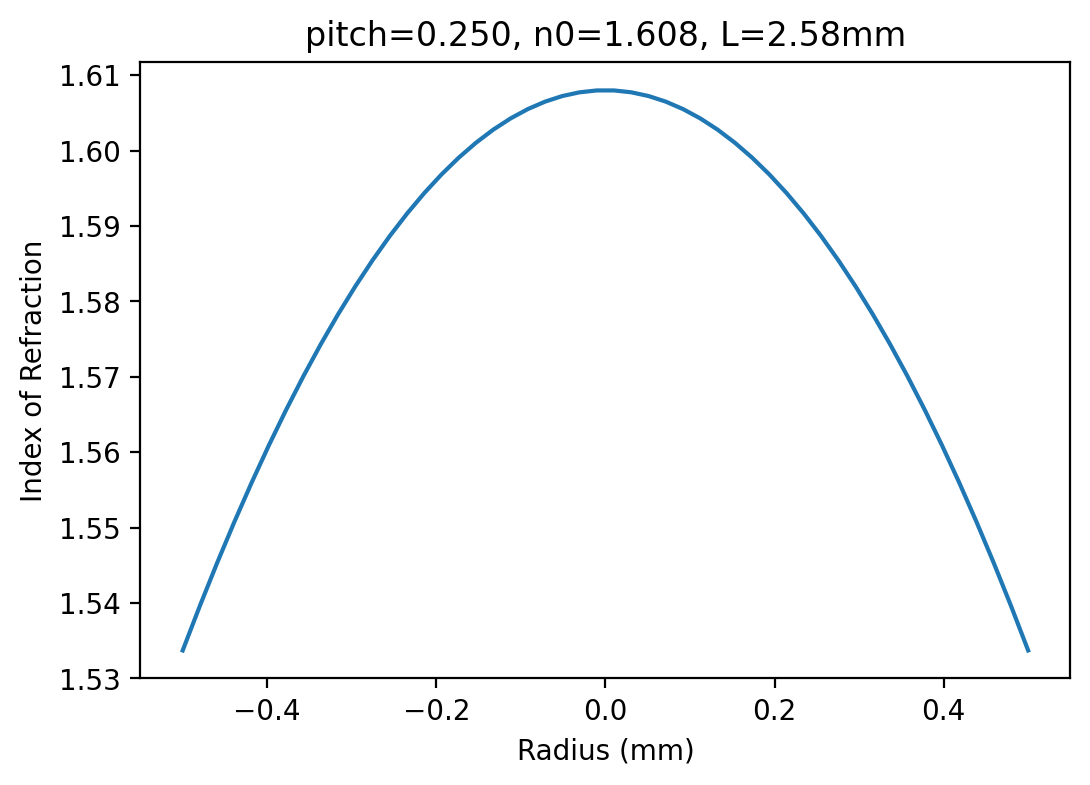
[12]:
pygrin.plot_principal_planes(n, pitch, length, diameter)
xpos = np.linspace(-diameter/2,diameter/2,7)
for pos in xpos:
z,r = pygrin.meridional_curve(n, pitch, length, pos, 0*np.pi/180)
plt.plot(z,r, color='blue',lw=0.5)
plt.title('Melles-Griot LGS-0.25-1.0-2.58-633')
plt.show()
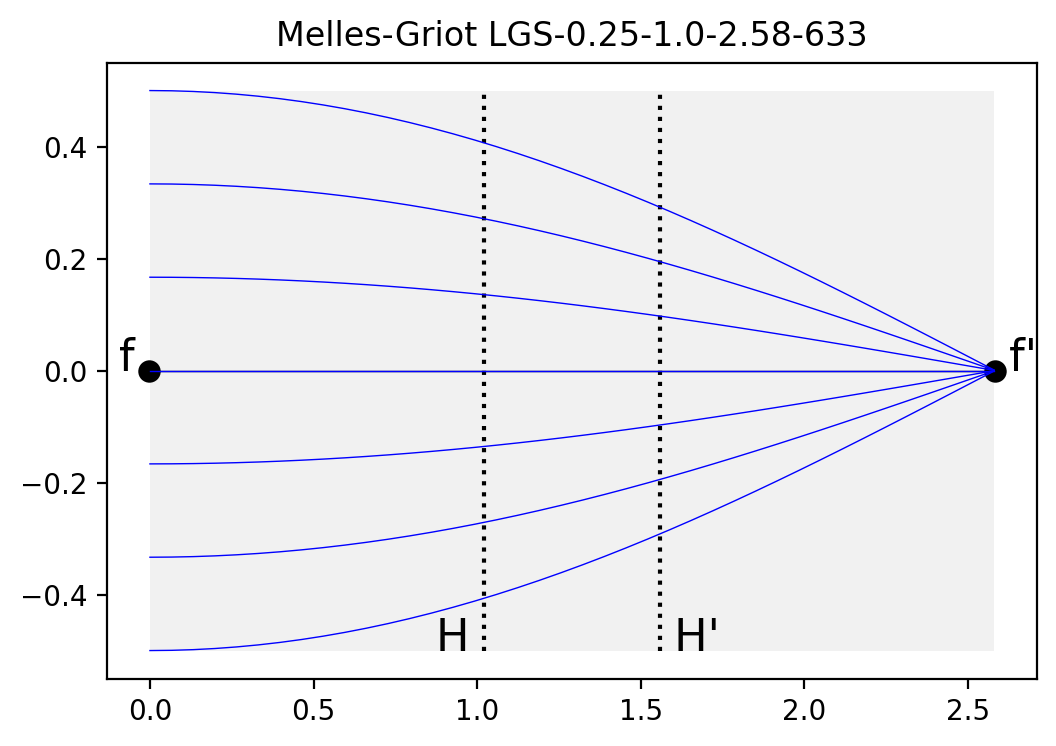
Grin Lens from ancient Melles Griot Catalog, 4.67 line 5
Part number LGE-0.29-1.8-5.37-633
[13]:
n = 1.608
gradient = 0.339
length = 5.37
diameter = 1.8
pitch = pygrin.period(gradient, length)
print('expected pitch = 0.29, calculated %.2f'%pitch)
ffl = pygrin.FFL(n,pitch,length)
efl = pygrin.EFL(n,pitch,length)
print('expected FFL = 0.46, calculated %.2f'%ffl)
na = pygrin.NA(n,pitch,length,diameter)
print('expected NA = 0.46, calculated %.2f'%na)
angle = pygrin.max_angle(n,pitch,length,diameter)
print('expected full accept angle = 55°, calculated %.0f°'%(2*angle*180/np.pi))
print('working distance = %.2f mm'%(efl-ffl))
expected pitch = 0.29, calculated 0.29
expected FFL = 0.46, calculated 0.47
expected NA = 0.46, calculated 0.46
expected full accept angle = 55°, calculated 55°
working distance = 1.43 mm
[14]:
pygrin.plot_principal_planes(n, pitch, length, diameter)
xpos = np.linspace(-diameter/4, diameter/4,8)
for pos in xpos:
z,r = pygrin.full_meridional_curve(n, pitch, length, ffl-efl, 0, pos)
plt.plot(z,r, color='blue', lw=0.5)
plt.title('Melles-Griot LGE-0.29-1.8-5.37-633')
plt.show()
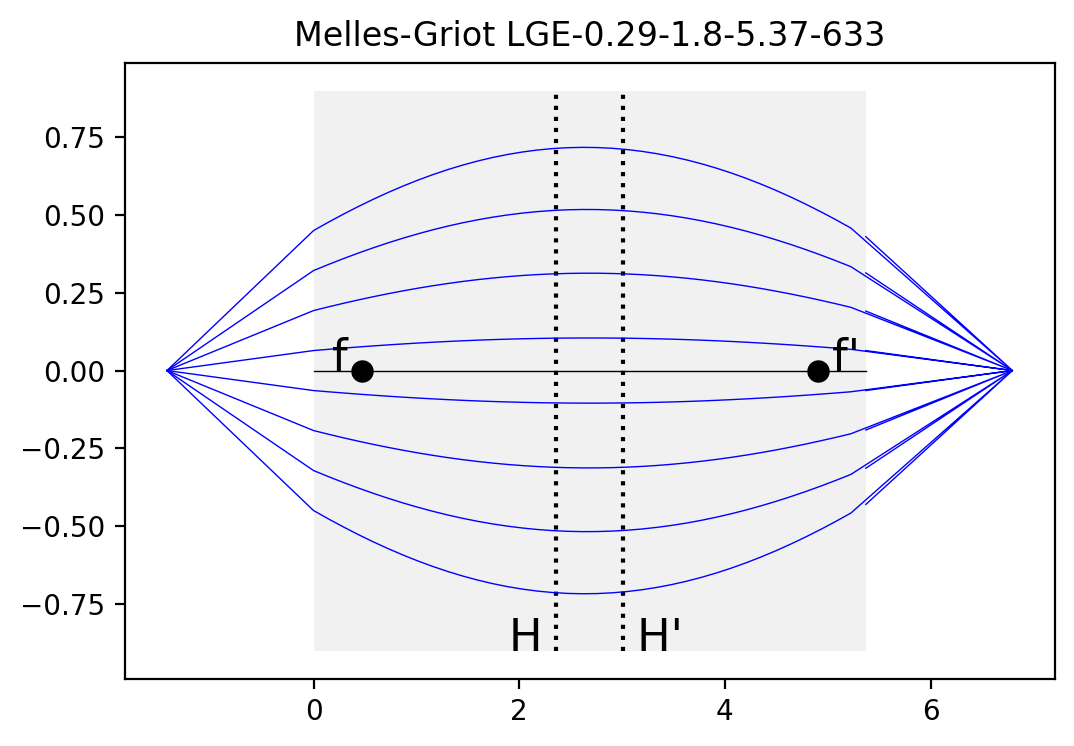
Riedl, page 96
[15]:
n = 1.5834
gradient = np.sqrt(0.1067)
length = 4
diameter = 1.8
pitch = pygrin.period(gradient, length)
print('expected pitch = 0.207, calculated %.3f'%pitch)
efl = pygrin.EFL(n,pitch,length)
print('expected EFL = 2.00, calculated %.2f'%efl)
ffl = pygrin.FFL(n,pitch,length)
print('expected FFL = -0.52, calculated %.2f'%ffl)
bfl = pygrin.BFL(n,pitch,length)
print('expected BFL = 4.52, calculated %.2f'%bfl)
na = pygrin.NA(n,pitch,length,diameter)
print('expected NA = 0.46, calculated %.2f'%na)
angle = pygrin.max_angle(n,pitch,length,diameter)
print('expected full accept angle = 55°, calculated %.0f°'%(2*angle*180/np.pi))
print('working distance = %.2f mm'%(-ffl+efl))
expected pitch = 0.207, calculated 0.208
expected EFL = 2.00, calculated 2.00
expected FFL = -0.52, calculated -0.52
expected BFL = 4.52, calculated 4.52
expected NA = 0.46, calculated 0.44
expected full accept angle = 55°, calculated 52°
working distance = 2.53 mm
[16]:
pygrin.plot_principal_planes(n, pitch, length, diameter)
xpos = np.linspace(-diameter/2, diameter/2,7)
for pos in xpos:
z,r = pygrin.full_meridional_curve(n, pitch, length, ffl-efl, pos, pos)
plt.plot(z,r, color='blue', lw=0.5)
plt.show()
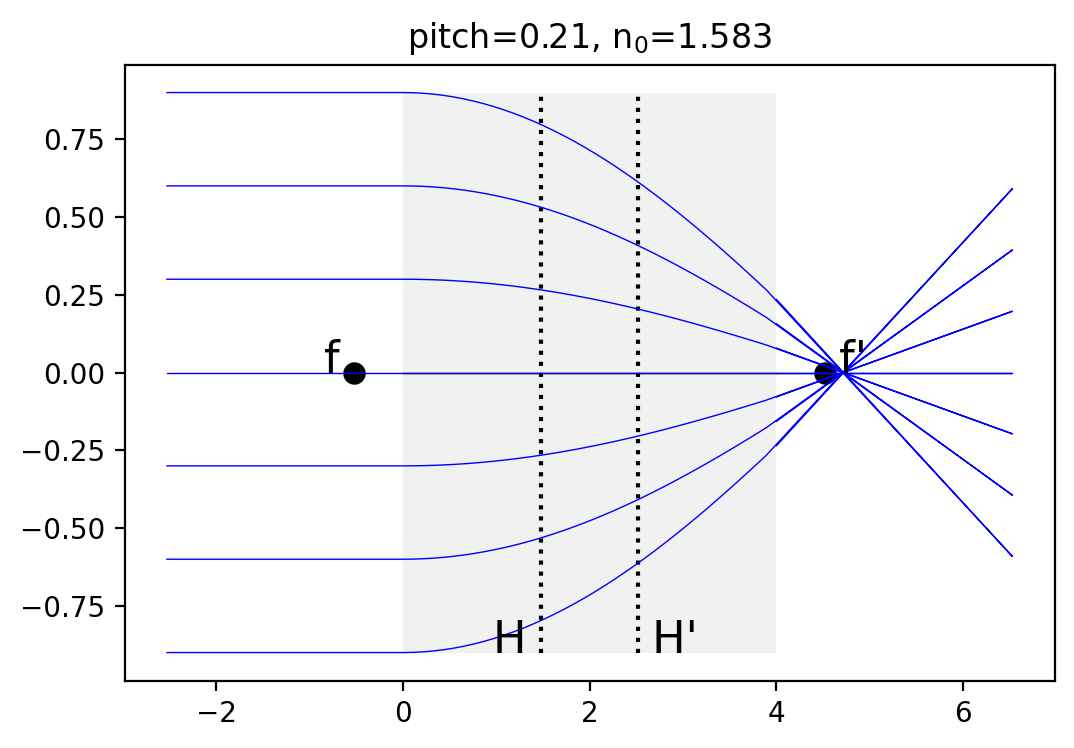
Grin Lenses at Oregon Tech
Oriel 41425
Designed for 632.8nm
[17]:
n = 1.608
pitch = 0.25
length = 6.28
diameter = 2
gradient = pygrin.gradient(pitch, length)
print('expected gradient = 0.250, calculated %.3f'%pitch)
efl = pygrin.EFL(n,pitch,length)
#print('expected EFL = 2.00, calculated %.2f'%efl)
ffl = pygrin.FFL(n,pitch,length)
#print('expected FFL = -0.52, calculated %.2f'%ffl)
bfl = pygrin.BFL(n,pitch,length)
#print('expected BFL = 4.52, calculated %.2f'%bfl)
na = pygrin.NA(n,pitch,length,diameter)
print('expected NA = 0.38, calculated %.2f'%na)
angle = pygrin.max_angle(n,pitch,length,diameter)
print('expected full accept angle = 45°, calculated %.0f°'%(2*angle*180/np.pi))
print('working distance = %.2f mm'%(efl-ffl))
expected gradient = 0.250, calculated 0.250
expected NA = 0.38, calculated 0.38
expected full accept angle = 45°, calculated 45°
working distance = 2.49 mm
[18]:
pygrin.plot_principal_planes(n, pitch, length, diameter)
xpos = np.linspace(-diameter/2, diameter/2,7)
for pos in xpos:
z,r = pygrin.full_meridional_curve(n, pitch, length, ffl-efl, pos, pos)
plt.plot(z,r, color='blue', lw=0.5)
plt.title('Oriel 41425')
plt.show()
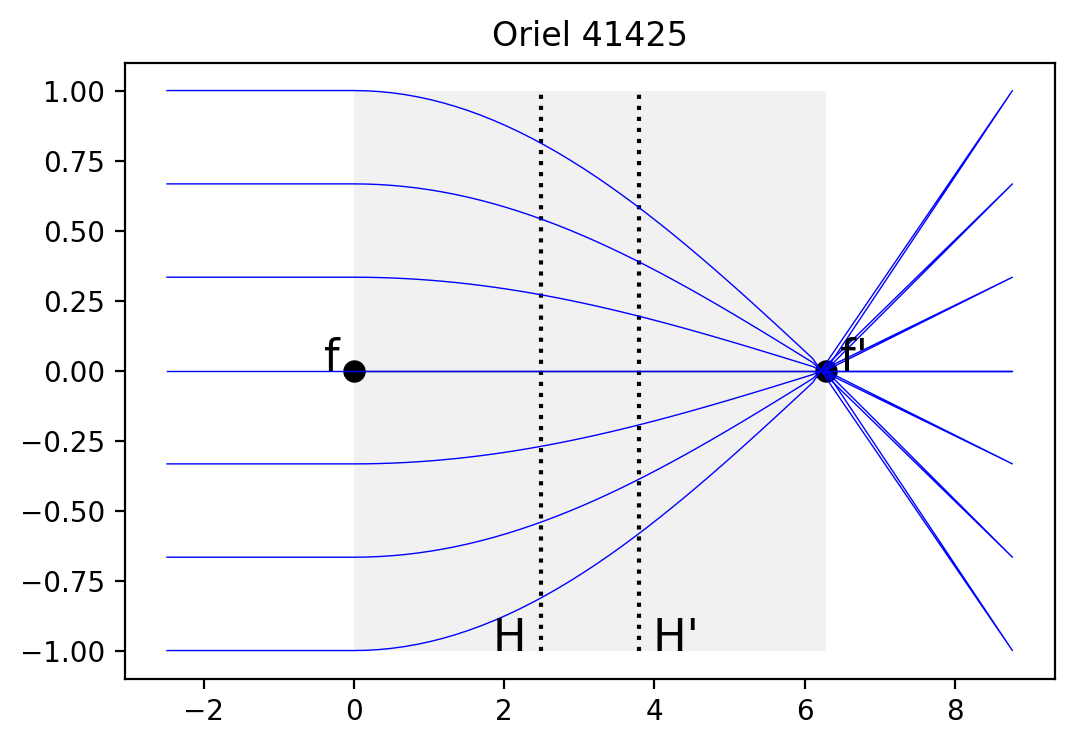
Oriel 41440
Designed for 632.8nm
[19]:
n = 1.608
pitch = 0.29
length = 5.35
diameter = 2
gradient = pygrin.gradient(pitch, length)
print('expected gradient = 0.290, calculated %.3f'%pitch)
efl = pygrin.EFL(n,pitch,length)
#print('expected EFL = 2.00, calculated %.2f'%efl)
ffl = pygrin.FFL(n,pitch,length)
#print('expected FFL = -0.52, calculated %.2f'%ffl)
bfl = pygrin.BFL(n,pitch,length)
#print('expected BFL = 4.52, calculated %.2f'%bfl)
na = pygrin.NA(n,pitch,length,diameter)
print('expected NA = 0.38, calculated %.2f'%na)
angle = pygrin.max_angle(n,pitch,length,diameter)
print('expected full accept angle = 60°, calculated %.0f°'%(2*angle*180/np.pi))
print('working distance = %.2f mm'%(efl-ffl))
expected gradient = 0.290, calculated 0.290
expected NA = 0.38, calculated 0.50
expected full accept angle = 60°, calculated 60°
working distance = 1.42 mm
[20]:
pygrin.plot_principal_planes(n, pitch, length, diameter)
xpos = np.linspace(-diameter/4, diameter/4,7)
for pos in xpos:
z,r = pygrin.full_meridional_curve(n, pitch, length, ffl-efl, 0, pos)
plt.plot(z,r, color='blue', lw=0.5)
plt.title('Oriel 41440')
plt.show()
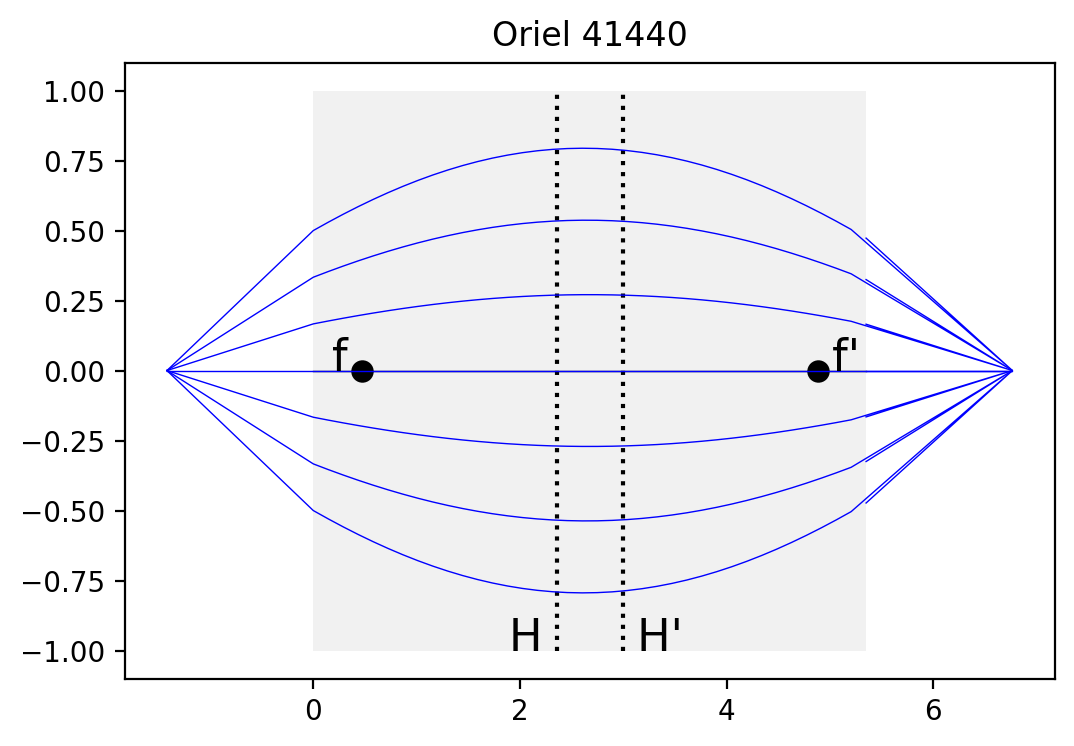
Newport FK - GR29
Designed for 850nm
[21]:
n = 1.608
pitch = 0.29
length = 5.49
diameter = 1.8
gradient = pygrin.gradient(pitch, length)
print('expected gradient = 0.290, calculated %.3f'%pitch)
efl = pygrin.EFL(n,pitch,length)
print('expected EFL = 1.95, calculated %.2f'%efl)
ffl = pygrin.FFL(n,pitch,length)
#print('expected FFL = -0.52, calculated %.2f'%ffl)
bfl = pygrin.BFL(n,pitch,length)
#print('expected BFL = 4.52, calculated %.2f'%bfl)
na = pygrin.NA(n,pitch,length,diameter)
print('expected NA = 0.46, calculated %.2f'%na)
angle = pygrin.max_angle(n,pitch,length,diameter)
print('expected full accept angle = 60°, calculated %.0f°'%(2*angle*180/np.pi))
print('working distance = %.2f mm'%(efl-ffl))
expected gradient = 0.290, calculated 0.290
expected EFL = 1.95, calculated 1.93
expected NA = 0.46, calculated 0.45
expected full accept angle = 60°, calculated 53°
working distance = 1.45 mm
[22]:
pygrin.plot_principal_planes(n, pitch, length, diameter)
xpos = np.linspace(-diameter/4, diameter/4,7)
for pos in xpos:
z,r = pygrin.full_meridional_curve(n, pitch, length, ffl-efl, 0, pos)
plt.plot(z,r, color='blue', lw=0.5)
plt.title('Newport FK-GR29')
plt.show()
